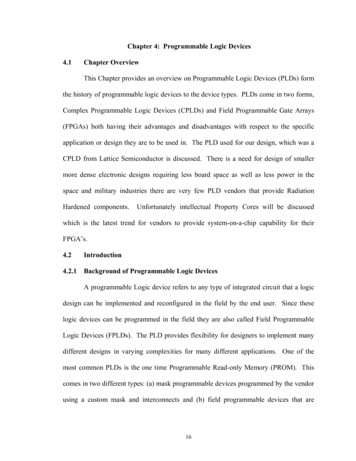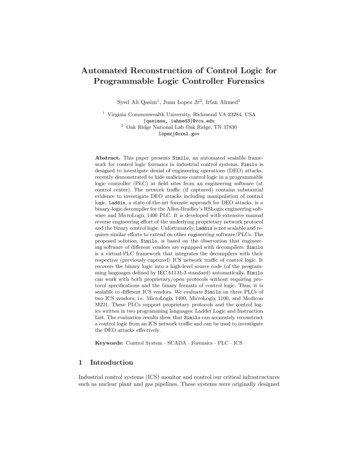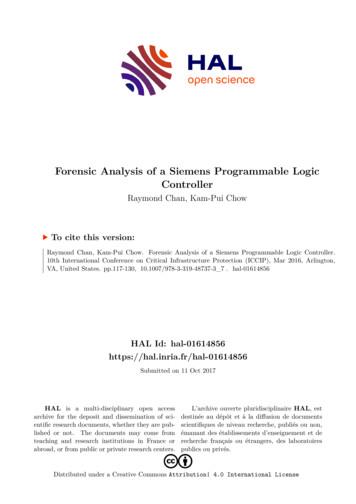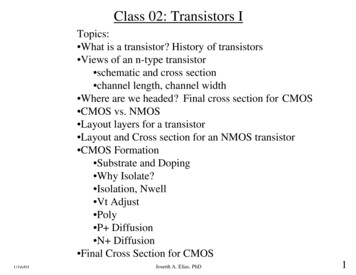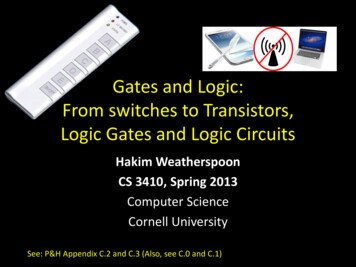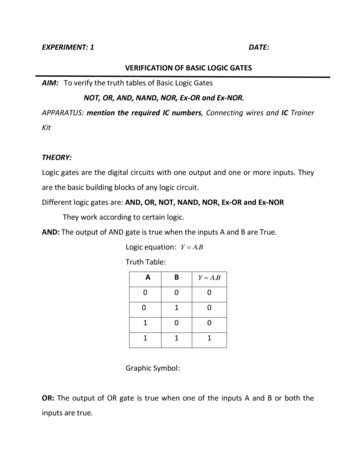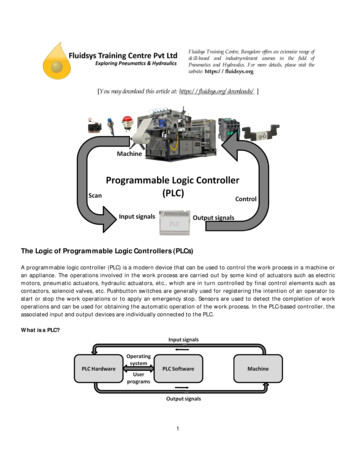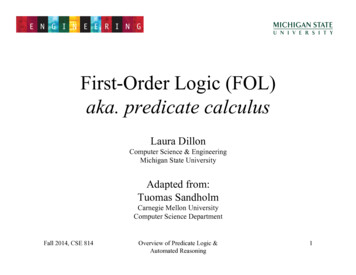
Transcription
First-Order Logic (FOL)aka. predicate calculusLaura DillonComputer Science & EngineeringMichigan State UniversityAdapted from:Tuomas SandholmCarnegie Mellon UniversityComputer Science DepartmentFall 2014, CSE 814Overview of Predicate Logic &Automated Reasoning1
Automated Inference in FOL Harder than in PL:– Variables can take on potentially an infinite number of possible valuesfrom their domain.– Hence there are potentially an infinite number of ways to apply theUniversal-Elimination rules of inference Goedel's Completeness Theorem: FOL entailment issemidecidable.– If a sentence is true given a set of axioms, there is a procedure that willdetermine this.– If the sentence is false, the procedure may never halt. Goedel's Incompleteness Theorem: In a slightly extendedlanguage (that enables mathematical induction), there areentailed sentences that cannot be proved.Fall 2014, CSE 814Overview of Predicate Logic &Automated Reasoning2
Inference Rules for FOLGeneralized Modus Ponens (GMP) Combines And-Introduction, Universal-Elimination, and ModusPonens (assumes free variables are universally quantified)– E.g.: from P(5), Q(5), and (P(x) Q(x)) R(x), deriveR(5) Need notation: term[v1/t1, v2/t2, ., vj/tj] means toreplace in term all occurrences of variable symbol vi by term ti,for i 1, 2, j.– E.g.: P(x)[x/5] stands for P(5)– E.g.: eats(y,x)[x/IceCream, y/Ziggy] stands foreats(Ziggy, IceCream)Fall 2014, CSE 814Overview of Predicate Logic &Automated Reasoning3
Inference Rules for FOLGeneralized Modus Ponens (GMP)Theta unifiesQi and Pi From:(Q1 Q2 QN) R,P1, P2, , PN,and Pi[Theta] Qi[Theta] for i 1,.,Nwhere P1, ,PN,Q1, ,QN and R are quantifier-free sentences; Theta [v1/t1, , vj/tj] ; v1, vj are variables; and t1, tj are terms.Infer: R[Theta]. resolventE.g.: from P(c), Q(c), and (P(x) Q(x) R(x)),P(x)[x/c] P(c)[x/c], and Q(x)[x/c] Q(c)[x/c], infer R(c)Fall 2014, CSE 814Overview of Predicate Logic &Automated Reasoning4
Unification Unification: a "pattern matching" procedure that,given two literals, returns a substitution that resultsin them matching, or "failure”.– I.e., unify(P,Q) Thetaonly if P[Theta] Q[Theta].– Moreover, when it succeeds, unification returns a mostgeneral unifier (mgu) To make literals match, the algorithm recursivelyreplaces variables by termsFall 2014, CSE 814Overview of Predicate Logic &Automated Reasoning5
Unification Algorithmprocedure unify(p, q, theta [])Scan p and q left-to-right.If p and q are equal, return theta (success)Otherwise, let r and s be the terms in p and q,respectively, where disagreement first occursIf r is a variable that does not occur in s, thenassign theta theta [r/s] and callunify(p[theta], q[theta], theta)else if s is a variable that does not occur in r, thenassign theta theta [s/r] and callunify(p[theta], q[theta], theta))else return "failure”Fall 2014, CSE 814Overview of Predicate Logic &Automated Reasoning6
Exampleunify( “parents(x, father(x), mother(Bill))”,“parents(Bill, father(y), z)”,[ ] )unify( “parents(Bill, father(Bill), mother(Bill))”,“parents(Bill, father(y), z)”,[“x”/“Bill”] )unify( “parents(Bill, father(Bill), mother(Bill))”,“parents(Bill, father(Bill), z)”,[“x”/“Bill”, “y”/“Bill”] )unify( “parents(Bill, father(Bill), mother(Bill))”,“parents(Bill, father(Bill), mother(Bill))”,[“x”/“Bill”, “y”/“Bill”,“z”/ “mother(Bill)”] )Fall 2014, CSE 814Overview of Predicate Logic &Automated Reasoning7
GMP in Horn FOL Generalized Modus Ponens is complete for Horn clauses– A Horn clause is a sentence of the form:(P1 P2 . Pn) Qwhere the Pi's and Q are positive literals (includes True)– We normally, True Q is abbreviated Q– Horn clauses represent a proper subset of FOL sentences.E.g., P(a) v Q(a) is a sentence but is not a Horn clause.Backward chainingGeneralized Modus PonensForward chainingFall 2014, CSE 814Overview of Predicate Logic &Automated Reasoning8
Example of forward chainingForward chaining: Start with the hypotheses; repeatedly use GMP to derivenew sentences until the conclusion is derived.Example:Given: All cats like fish, cats eat everything they like, and Ziggy is a cat.Therefore: Ziggy eats fishHypotheses in Horn FOL:1. cat(x) likes(x, Fish)2. (cat(x) likes(x,y)) eats(x,y)3. cat(Ziggy)Conclusion in Horn FOL: eats(Ziggy,Fish)FC GMP Proof:4. Use GMP with 1, 3, and [x/Ziggy] to derive: likes(Ziggy,Fish)5. Use GMP with 3, 4, 2 and [y/Fish, x/Ziggy] toderive eats(Ziggy, Fish)Fall 2014, CSE 814Overview of Predicate Logic &Automated Reasoning9
(Slightly) More Interesting ExamplePremises:cat(x) fish(y) likes(x, y)cat(x) rodent(y) likes(x, y)cat(x) bird(y) likes(x, y)flies(x) feathers(x) s(Robin)feathers(Robin)Conclusion:likes(Ziggy, Robin)Fall 2014, CSE 814Overview of Predicate Logic &Automated Reasoning10
Simple FC algorithmFor a set of horn clauses H and atom qinfer(H, q):if q[theta] r[theta] for some h in Hand unifier theta, return True;let R be the set of resolventsproducible from H using GMP;if R is empty, return Falseelse return infer(H U R, q);Fall 2014, CSE 814Overview of Predicate Logic &Automated Reasoning11
1st call to (FC) inferH: cat(x) fish(y) likes(x, y)cat(x) rodent(y) likes(x, y)cat(x) bird(y) likes(x, y)flies(x) feathers(x) s(Robin)feathers(Robin)R: likes(Ziggy, Sebastian)q: likes(Ziggy, Robin)Fall 2014, CSE 814likes(Ziggy, Mickey)bird(Robin)Overview of Predicate Logic &Automated Reasoning12
2nd call to (FC) inferH: cat(x) fish(y) likes(x, y)cat(x) rodent(y) likes(x, y)cat(x) bird(y) likes(x, y)flies(x) feathers(x) s(Robin)feathers(Robin)likes(Ziggy, Sebastian)likes(Ziggy, Mickey)bird(Robin)q: likes(Ziggy, Robin)Fall 2014, CSE 814R: likes(Ziggy, Robin)Overview of Predicate Logic &Automated Reasoning13
Example of backward chainingBackward chaining: start with the goal query, repeatedly replace goals withantecedents derived from known implications, working "backwards" untilleft only with hypotheses.Hypotheses in Horn FOL:1. cat(x) likes(x, Fish)2. (cat(x) likes(x,y)) eats(x,y)3. cat(Ziggy)BC GMP Proof of eats(Ziggy, Fish):4. eats(Ziggy, Fish) matches RHS of 2 with [x/Ziggy,y/Fish], soreplace it with new goals:cat(Ziggy) and likes(Ziggy, Fish)5. likes(Ziggy, Fish) matches RHS of 1 with [x/Ziggy], so replace itwith:cat(Ziggy)6. cat(Ziggy)is a hypothesis, so goals are all proved.Fall 2014, CSE 814Overview of Predicate Logic &Automated Reasoning14
(Slightly) More Interesting ExamplePremises:cat(x) fish(y) likes(x, y)cat(x) rodent(y) likes(x, y)cat(x) bird(y) likes(x, y)flies(x) feathers(x) s(Robin)feathers(Robin)Conclusion:likes(Ziggy, Robin)Fall 2014, CSE 814Overview of Predicate Logic &Automated Reasoning15
Simple BC algorithmH:set of Horn clauses (hypotheses), G:non-empty set of atoms (goals)W:list of sets of atoms (working list of sets of goals)infer(H, G, W):if G {True}: return Trueelse:choose g ( True) in G;let H’ be the set of clauses in Hwhose RHS unifies with g;# choice 1if H’ is empty and W is empty: return Falseelse if H’ is empty: return infer(H, W[0], W[1:])else:G’ G\{g} U p1[th1]# choice 2W’ W [G\{g} U p2[th2], ,G\{g} U pk[thk]where H’ { pi ci }i 1 k andg[thi] ci[thi], for i 1 kreturn infer(H, G’, W’)Fall 2014, CSE 814Overview of Predicate Logic &Automated Reasoning16
1st call to (BC) inferHgcat(x) fish(y) likes(x, y)cat(x) rodent(y) likes(x, y)cat(x) bird(y) likes(x, y)flies(x) feathers(x) s(Robin)feathers(Robin)likes(Ziggy, Robin)GW [ ]G’ cat(Ziggy)fish(Robin)W’H’ cat(x) fish(y) likes(x, y)cat(x) rodent(y) likes(x, y)cat(x) bird(y) likes(x, y)Fall 2014, CSE 814likes(Ziggy, Robin)Overview of Predicate Logic &Automated in)17
2nd call to (BC) inferHgcat(x) fish(y) likes(x, y)cat(x) rodent(y) likes(x, y)cat(x) bird(y) likes(x, y)flies(x) feathers(x) H’ True cat(Ziggy)W’cat(Ziggy)bird(Robin)G’ Truefish(Robin)Fall 2014, CSE 814cat(Ziggy)rodent(Robin)Overview of Predicate Logic &Automated Reasoning18
3rd call to (BC) inferHgcat(x) fish(y) likes(x, y)cat(x) rodent(y) likes(x, y)cat(x) bird(y) likes(x, y)flies(x) feathers(x) all 2014, CSE 814Overview of Predicate Logic &Automated Reasoning19
4th call to (BC) inferHcat(x) fish(y) likes(x, y)cat(x) rodent(y) likes(x, y)cat(x) bird(y) likes(x, y)flies(x) feathers(x) t(Ziggy)bird(Robin)And so on Fall 2014, CSE 814Overview of Predicate Logic &Automated Reasoning20
Incompleteness of GMP x x x xP(x) Q(x) P(x) R(x)Q(x) S(x)R(x) S(x)! Cannot be converted to HornFor any constant A, S(A)is entailed; but it cannot beinferred using GMPIncomplete: there are entailed sentences that theprocedure cannot infer.Fall 2014, CSE 814Overview of Predicate Logic &Automated Reasoning21
Resolution ProcedureRecall Resolution Rule for PL:From P1 v P2 v . v Pn and P1 v Q2 v . v Qminfer the resolvent sentence:P2 v . v Pn v Q2 v . v QmExamples––––From P and P v Q, derive Q (Modus Ponens)From ( P v Q) and ( Q v R), derive P v R (Disj. syl.)From P and P, derive False(Contradication)From (P v Q) and ( P v Q), derive True (Tautology)Fall 2014, CSE 814Overview of Predicate Logic &Automated Reasoning22
Resolution Procedure Resolution Rule for FOL:– From sentencesP1 v . v Pn and Q1 v . v Qmwhere each Pi and Qi is a literal,– If P1 and Q1 unify with substitution Theta,i.e., if P1[Theta] Q1[Theta]– Then infer the resolvent sentence:(P2 v v Pn v Q2 v v Qm)[Theta] Example– From P(x, f(a)) vP(x, f(y)) P(z, w)v Q(z,w)with substitution [x/z, w/f(a)]:vQ(y,x)and– Infer:P(z, f(y)) v Q(y,z) v Q(z,f(a))Fall 2014, CSE 814Overview of Predicate Logic &Automated Reasoning23
Resolution Procedure Proof by contradiction method: Refutation Procedure Given a consistent set of hypotheses H and goal sentence Q, wewant to show that H Q – ie., that every interpretation Ithat satisfies H, satisfies Q. We know that any interpretation I satisfies either Q or Q, butnot both. Therefore H Q if and only if no interpretation satisfies bothH and Q. In other words, (H Q) (H Q False) What's the gain? If H union Q is unsatisfiable, then some finitesubset is unsatisfiable.Fall 2014, CSE 814Overview of Predicate Logic &Automated Reasoning24
Resolution Procedure Resolution procedure cannot, in general, be used to generate alllogical consequences of a set sentences. Resolution procedure cannot be used to prove that Q is notentailed by H. Resolution procedure won't always give an answer sinceentailment is only semidecidable. (You can't just run two proofsin parallel, one trying to prove Q and the other trying to prove Q, since H might not entail either one.)Fall 2014, CSE 814Overview of Predicate Logic &Automated Reasoning25
Resolution Algorithmprocedure resolution-refutation(H, Q);; H is a set of consistent, true FOL sentences;; Q is a goal sentence that we want to derive;; return success if H Q, and failure otherwiseK union(KB, Q)while false not in K doif 2 sentences, S1 and S2, in K containliterals that unify, then:resolvent resolution-rule(S1, S2)K union(K, resolvent)else:return “failure”return "success"Fall 2014, CSE 814Overview of Predicate Logic &Automated Reasoning26
Resolution example (using PL sentences) From “Heads I win and tails you lose” prove that “I win” First, define the hypotheses :1. "Heads I win, tails you lose."(Heads IWin), i.e. ( Heads v IWin)(Tails YouLose), i.e. ( Tails v YouLose)2. Add some axioms about coins, winning, and losing:(Heads v Tails)(YouLose IWin), i.e. ( YouLose v IWin)(IWin YouLose), i.e. ( IWin v YouLose) Goal: IWinFall 2014, CSE 814Overview of Predicate Logic &Automated Reasoning27
Resolution example (using PL sentences) IWin Heads v IWinFalse HeadsTailsHeads v TailsYouLose Tails v YouLoseIWin YouLose v IWin IWin v YouLoseFall 2014, CSE 814Overview of Predicate Logic &Automated Reasoning28
Problems yet to be addressed Resolution rule requires sentences in clause form:P1 v P2 v . v Pn,where each Pi is a literal (negated or nonnegatedpredicate applied to functions, constants, or variables). Resolution strategy– How to pick which pair of sentences to resolve?– How to pick which pair of literals to unify?Fall 2014, CSE 814Overview of Predicate Logic &Automated Reasoning29
Converting FOL sentences to clause formSteps to convert a sentence to clause form:1.Eliminate all connectives:replace (P Q) by ((P Q) (Q P))2.Eliminate all connectives:replace (P Q) by ( P v Q)3.Reduce scope of negation to a single predicate:– replace P by P– replace (P v Q) by ( P Q)– replace (P Q) by ( P v Q)– replace (Ax)P by (Ex) P– replace (Ex)P by (Ax) PStandardize variables:rename so each quantifier has its own unique variable name.4.Fall 2014, CSE 814Overview of Predicate Logic &Automated Reasoning30
Converting FOL sentences to clause form 5.Eliminate existential quantification: Skolemization–If the existential quantifier is within the scope of a universallyquantified variable, introduce a new function that depends on theuniversally quantified variable. –E.g., (Ax)(Ay)(Ez)P(x,y z) is converted to(Ax)P(x, y, f(x, y)).(Ax)(Ey)loves(x,y) is converted to (Ax)loves(x,g(x))where in this case g(x) specifies a person that x loves.f is called a Skolem function, and must be a brand new function namethat does not occur in any other sentence in the entire KB.If not, introduce a new constant E.g., (Ex)P(x) to P(c) where c is a brand new constant symbol thatis not used in any other sentence.c is called a Skolem constant.Fall 2014, CSE 814Overview of Predicate Logic &Automated Reasoning31
Converting FOL sentences to clause form 6.Remove universal quantification symbols:make scope of each be the entire sentence, so can just “drop” them 7.E.g., convert (Ax)P(x) V (Ay)Q(y) to P(x) V Q(y)Put in conjunctive normal form: Distribute V into E.g., convert (P Q) v R to (P v R) (Q v R)E.g., convert (P v Q) v R to (P v Q v R)8.Split each conjunct into a separate clause--a disjunction of literals9.Standardize variables apart again so that each clause containsvariable names that do not occur in any other clauseFall 2014, CSE 814Overview of Predicate Logic &Automated Reasoning32
Converting FOL sentences to clause form Example: Convert the sentence(Ax)( (Ay)( p(f(x,y)) (Ez)( q(y,z) p(g(z))) ) p(x) )1.Eliminate Nothing to do here.2.Eliminate (Ax)( (Ay)( p(f(x,y)) (Ez)(q(y,z) V p(g(z))) ) p(x) )3.Reduce scope of negation(Ax)( (Ey)( p(f(x,y)) V (Ez)(q(y,z) V p(g(z))) ) p(x) )(Ax)( (Ey)( p(f(x,y)) V (Az)( q(y,z) p(g(z))) ) p(x) )Fall 2014, CSE 814Overview of Predicate Logic &Automated Reasoning33
Converting FOL sentences to clause form 4.Standardize variables (nothing to do here)(Ax)( (Ey)( p(f(x,y)) V (Az)( q(y,z) p(g(z))) ) p(x) )5.Eliminate existential quantification(Ax)( ( p(f(x,h(x))) V (Az)( q(h(x),z) p(g(z))) ) p(x) )6.Drop universal quantification symbols( p(f(x,h(x))) V ( q(h(x),z) p(g(z))) ) p(x)7.Convert to conjunction of disjunctions( p(f(x,h(x))) V q(h(x),z) ) ( p(f(x,h(x))) V p(g(z)) ) Fall 2014, CSE 814p(x)Overview of Predicate Logic &Automated Reasoning34
Converting FOL sentences to clause form 8. Create separate clauses––– P(f(x,h(x))) V q(h(x),z) P(f(x,h(x))) V p(g(z))P(x)9. Standardize variables–––Fall 2014, CSE 814 P(f(x,h(x))) V q(h(x),z) P(f(y,h(y))) V p(g(w))P(v)Overview of Predicate Logic &Automated Reasoning35
Example: A resolution graph P(f(x,h(x))) V q(h(x),z) P(f(y,h(y))) V p(g(w))[v/f(y,h(y)]P(v) p(g(w))False[v/g(w)]Thus, the original formula is unsatisfiable (its negationis true).Fall 2014, CSE 814Overview of Predicate Logic &Automated Reasoning36
Example: Hoofers Club [example from Charles Dyer] Problem Statement: Tony, Shi-Kuo and Ellen belong tothe Hoofers Club. Every member of the Hoofers Club iseither a skier or a mountain climber or both. No mountainclimber likes rain, and all skiers like snow. Ellen dislikeswhatever Tony likes and likes whatever Tony dislikes.Tony likes rain and snow. Query: Is there a member of the Hoofers Club who is amountain climber but not a skier?Fall 2014, CSE 814Overview of Predicate Logic &Automated Reasoning37
Example: Hoofers Club Translation into FOL Sentences Let S(x) mean x is a skier, M(x) mean x is a mountain climber, and L(x,y)mean x likes y, where the domain of the first variable is Hoofers Clubmembers, and the domain of the second variable is snow and rain. We cannow translate the above English sentences into the following FOL wffs:1.2.3.4.5.6.(Ax) S(x) v M(x) (Ex) M(x) L(x, Rain)(Ax) S(x) L(x, Snow)(Ay) L(Ellen, y) L(Tony, y)L(Tony, Rain)L(Tony, Snow)7. Query: (Ex) M(x) S(x)8. Negation of the Query: (Ex) M(x) S(x)Fall 2014, CSE 814Overview of Predicate Logic &Automated Reasoning38
Example: Hoofers Club Conversion to Clause Form1.2.3.4.5.6.7.8.S(x1) v M(x1) M(x2) v L(x2, Rain) S(x3) v L(x3, Snow) L(Tony, x4) v L(Ellen, x4)L(Tony, x5) v L(Ellen, x5)L(Tony, Rain)L(Tony, Snow)Negation of the Query: M(x7) v S(x7)Fall 2014, CSE 814Overview of Predicate Logic &Automated Reasoning39
Example: Hoofers Club 8. M(x7) v S(x7)[x7/x1]S(x1)[x1/x3]1. S(x1) v M(x1))L(x3, Snow)[x4/Snow,x3/Ellen]3. S(x3) v L(x3, Snow)[x4/Snow,x3/Ellen] L(Tony, x4)4. L(Tony, x4) v L(Ellen, x4)False7. L(Tony, Snow)Fall 2014, CSE 814Overview of Predicate Logic &Automated Reasoning40
Example: Hoofers Club Recall original question:Given the hypotheses below1.2.3.4.5.6.(Ax) S(x) v M(x) (Ex) M(x) L(x, Rain)(Ax) S(x) L(x, Snow)(Ay) L(Ellen, y) L(Tony, y)L(Tony, Rain)L(Tony, Snow)Can we infer the conclusion: (Ex)(M(x) S(x))When provable, resolution can find a “witness” for x!Fall 2014, CSE 814Overview of Predicate Logic &Automated Reasoning41
Example: Hoofers Club 8. M(x7) v S(x7)[x7/x1]S(x1)[x1/x3]1. S(x1) v M(x1))L(x3, Snow)[x4/Snow,x3/Ellen]3. S(x3) v L(x3, Snow)[x4/Snow,x3/Ellen] L(Tony, x4)4. L(Tony, x4) v L(Ellen, x4)To find a witness:use the substitutions to rewrite original(unnegated) goal:M(x7) S(x7)Fall 2014, CSE 814M(x1) S(x1)False7. L(Tony, Snow)M(x3) S(x3)Overview of Predicate Logic &Automated ReasoningM(Ellen) S(Ellen)42
Subsumption Motivation: Helps keep K small lesssearch Never keep more specific (“subsumed”)sentences in the K than more general ones E.g., if the K has P(x), then eliminate– P(c)– P(a) v P(b)Fall 2014, CSE 814Overview of Predicate Logic &Automated Reasoning43
Strategies to control the search Breadth-First– Compute all level 1 clauses possible, then all possible level 2 clauses, etc.– Complete, but very inefficient. Set-of-Support– At least one parent clause must be from the negation of the goal or one of the"descendents" of such a goal clause (i.e., derived from a goal clause)– Complete (assuming all possible set-of-support clauses are derived) Unit Resolution– At least one parent clause must be a "unit clause," (clause containing a single literal)– Not complete in general, but complete for Horn clauses Input Resolution– At least one parent from the original hypotheses or the negation of the goal– Not complete in general, but complete for Horn clauses Linear Resolution– P and Q can be resolved together if P is from the original hypotheses or the negationof the goal or if P is an ancestor of Q in the proof tree– CompleteFall 2014, CSE 814Overview of Predicate Logic &Automated Reasoning44
GMP in Horn FOL Generalized Modus Ponens is complete for Horn clauses - A Horn clause is a sentence of the form: (P1 P2 . Pn) Q where the Pi's and Q are positive literals (includes True) - We normally, True Q is abbreviated Q - Horn clauses represent a proper subset of FOL sentences.

